#National pearl harbor remembrance day.
Text
National pearl harbor remembrance day.

He managed to shoot down between four and six Japanese planes before being ordered to abandon ship. Miller later became the first African-American to receive the Navy Cross. Cook Third Class Doris “Dorie” Miller, who served on the USS West Virgina, took over a 50-caliber Browning anti-aircraft machine gun, despite having little to no experience with the weapon.The USS Arizona continues to leak oil to this day, with the black spots often called the “tears of the Arizona.”.Both the USS Utah and USS Arizona were declared National Historic Landmarks in 1989.Not only does Remembrance Day serve as a way to educate American citizens about what happened on December 7 th, 1941, but it serves as a way to honor the 2,403 lives lost in the attack. Just as we strive to preserve the legacies of those are who served throughout the museum, Remembrance Day strives to preserve the legacies of those who lost their lives at Pearl Harbor through stories and memorials. Pearl Harbor Remembrance Day is a prime example of what we hope to do at NVMM. solidly into WWII.ĭecades later, on August 23, 1994, Congress would declare December 7 th as National Pearl Harbor Remembrance Day. Flags are flown at half-mast and events are held throughout the country, including at the Pearl Harbor Memorial and Hawaii. Just three days later, Germany and Italy declared war on the United States. Congress then turned right around and declared war on Germany and Italy, bringing the U.S. I believe that I interpret the will of the Congress and of the people when I assert that we will not only defend ourselves to the uttermost but will make it very certain that this form of treachery shall never again endanger us.” No matter how long it may take us to overcome this premeditated invasion, the American people in their righteous might will win through to absolute victory. Navy battleships, the USS Arizona and the USS Utah, permanently sank.Ĭontinuing in his speech, Roosevelt said, “ But always will our whole Nation remember the character of the onslaught against us. Additionally, 1,178 were injured, 188 aircraft were destroyed, and two U.S. on December 7, 1941, resulted in the deaths of 2,403 civilians and service members. The attack, which occurred just before 8 a.m. ships as possible, so that nothing could hinder Japan’s forces as they conquered the South Pacific. Any attack from Japan was expected to happen in other areas of the South Pacific, which meant that the Pearl Harbor base was left largely undefended. Almost the entirety of the U.S.’s Pacific fleet and hundreds of aircraft were located at Pearl Harbor. The motive behind the plan was to destroy as many U.S. and Japan for some time, the attack came completely as a surprise. Roosevelt following the Japanese attack on the Pearl Harbor naval base near Honolulu, Hawaii. Just one hour after this speech, Congress would pass an official declaration of war on Japan, bringing the United States into WWII.Īlthough tensions had been rising between the U.S. These were the words spoken by President Franklin D. “Yesterday, Decem– a date which will live in infamy – the United States of America was suddenly and deliberately attacked by naval and air forces of the Empire of Japan.”

0 notes
Photo
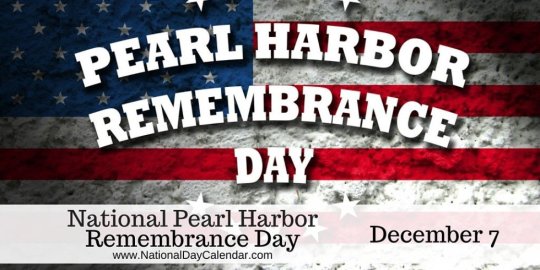
Happy National Pearl Harbor Remembrance Day!
#national pearl harbor remembrance day#pearl harbor#the day that will live in infamy#national days of stuff#holiday
6 notes
·
View notes
Photo





National Pearl Harbor Remembrance Day
On the morning of December 7, 1941, Japan launched a surprise attack on Naval Station Pearl Harbor, located in Honolulu, Hawaii, on the island of Oahu. National Pearl Harbor Remembrance Day remembers and honors the 2,403 citizens of the United States who lost their lives there that day. Veterans and citizens have commemorated the anniversary of the attack on Pearl Harbor since it took place, but the day became an official observance when Congress designated the day with a joint resolution on October 3, 1984. The resolution authorized and requested the President to issue a proclamation calling upon the people of the United States "to observe this solemn occasion with appropriate ceremonies and activities" and "to pledge eternal vigilance and strong resolve to defend this Nation and its allies from all future aggression." Accordingly, President Ronald Reagan issued Proclamation 5286 on December 4, 1984. Subsequent Congresses and presidents have passed resolutions and issued proclamations for the day. On the day, flags are flown at half-staff until sunset to honor those who died from the attacks. Events, including a commemoration ceremony, are held at the Pearl Harbor National Memorial.
Although the attack on Pearl Harbor was a surprise, tensions had been building between the United States and Japan for years. In the 1930s, Japan expanded into China, taking over its import market, agitating the United States. Japan invaded China in 1937 and subsequently participated in the Nanjing Massacre. During the following year, the United States gave its first loan to China. The United States instituted economic sanctions and trade embargoes with hopes they would keep Japan from expanding. In July 1939, the United States terminated the Treaty of Commerce and Navigation, which had stood with Japan since 1911. In the summer of 1940, the United States began restricting the export of some materials to Japan that would be useful to them in war. In July 1941, all commercial and financial connections with Japan were cut off, Japan's assets were frozen, and an embargo was placed on petroleum and other war materials. Concurrently, the United States stepped up aid to China, which did not please Japan's militarists. Japan did not shift course and tensions continued to rise.
Japan ordered the attack on November 5, but negotiations took place between Japan and the United States right up until the day of the attack, and Japan's commanders were told that they may be recalled if negotiations produced a favorable outcome. On November 26, the Japanese fleet stationed itself about 275 miles north of Hawaii. It was from this location that around 360 planes eventually launched to Pearl Harbor.
On more than one occasion, most notably on November 27, U.S. Army and Navy commanders at Pearl Harbor were warned that an attack was possible. They took some steps, but as they did not think that an attack would happen, their preparations were far from adequate. Washington didn't take the steps that were needed to be prepared either—they didn't expect Japan to attack Hawaii as Japan was about 4,000 miles from the island and Hawaii was about 2,000 miles from mainland United States. There were also some indications right before the attack that should have raised red flags that one was imminent. Early on the morning of the attack, it was learned in Washington that the Japanese ambassadors wanted an interview with the secretary of state at 1:00 p.m. (7:30 a.m. Hawaii time), which signaled war. Meanwhile, in Pearl Harbor, a Japanese submarine was spotted by a minesweeper four hours before the attack. Then, an hour and a half before the attack, the USS Ward, a destroyer, transmitted a message saying that it had engaged the submarine. Additionally, U.S. Army Pvt. George Elliott detected incoming planes on a radar screen, but he was told by his lieutenant that B-17 bombers from the United States were soon to arrive, so he should disregard what he saw.
On the morning of Sunday, December 7, 1941, at 7:55 a.m. Hawaii time, the first of hundreds of fighter planes, bombers, and torpedo planes of the Imperial Japanese Navy Air Service attacked Naval Station Pearl Harbor. After much success, Japan launched a second wave of attack at 8:50 a.m., which lasted until shortly after 9 a.m. Most of the United States Pacific Fleet was moored around Ford Island in the center of the harbor at the time, and many airplanes were parked at nearby airfields. Japan's goal was to take out the fleet, and then to go on to other parts of the South Pacific, which the United States would then be unable to defend.
The attack on Pearl Harbor left 2,403 United States citizens dead, including 2,335 service members and 68 civilians. Additionally, 1,178 Americans were injured. Most of the damage was done in the first 30 minutes of the attack. Around 8:10 a.m., a 1,800-pound bomb was dropped on the USS Arizona, which went through the deck and into the forward ammunition magazine, causing the ship to explode and 1,177 of its crew members to perish. Following the destruction of the USS Arizona, torpedoes hit the USS Oklahoma, which sank, causing the loss of life of 400 sailors. The USS Utah—a battleship that was converted to a target ship in 1931—was sunk and 58 lost their lives. The rest of the battleships at the harbor were either sunk or damaged, and there were casualties on each vessel, including the USS California, USS West Virginia, USS Maryland, USS Pennsylvania, USS Tennessee, and USS Nevada. Each of these six battleships would eventually be returned to service. Three destroyers, three cruisers, and one minelayer were damaged. Aircraft were also targeted, with 159 being damaged and 188 being destroyed, most while parked at Naval Air Station on Ford Island and at nearby Wheeler and Hickam fields.
Although these losses and damages were disastrous for the United States, the Pacific Fleet's three aircraft carriers were away from the base at the time, remaining unscathed, which was of immense importance. Some cruisers and destroyers were also near the aircraft carriers, out of harm's way. Of additional importance, parts of Pearl Harbor—submarine docks, shipyards, repair shops, and oil storage depots—were not harmed. As for the Japanese, they lost fewer than 100 men, 60 or fewer planes, five midget submarines, and perhaps one or two fleet submarines in the attack.
The events of Pearl Harbor unified the American public and precipitated the almost immediate entry of the country into World War II. The day after the attack, President Franklin Delano Roosevelt made a speech to Congress in which he said December 7, 1941, was "a date which will live in infamy." He went on to say, "No matter how long it may take us to overcome this premeditated invasion, the American people in their righteous might will win through to absolute victory. I believe I interpret the will of the Congress and of the people when I assert that we will not only defend ourselves to the uttermost, but will make very certain that this form of treachery shall never endanger us again." He closed out his speech by asking Congress to declare war on Japan. Congress declared war the same day and the United States entered World War II on the side of the Allies. When Germany and Italy declared war on the United States three days later, the US declared war on them as well.
On National Pearl Harbor Remembrance Day, we remember and honor those who lost their lives on today's date in 1941 at Pearl Harbor. We fly the flag at half-staff and attend events in their honor. We remember the great significance of the day and how it brought the United States into World War II, forever changing the nation.
How to Observe National Pearl Harbor Remembrance Day
The day should be spent remembering and showing honor for those who lost their lives at Pearl Harbor. The following are some ideas on how to observe the day:
Attend the National Pearl Harbor Remembrance Day Commemoration Ceremony, which takes place outside of the Pearl Harbor Visitor Center at the Pearl Harbor National Memorial. If you are unable to attend, you can view its live broadcast online. Other events are also held at Pearl Harbor on today's anniversary.
Visit the Pearl Harbor National Memorial. This site is home to the USS Arizona Memorial. Dedicated on Memorial Day in 1962, the ship's memorial is located over the sunken battleship. It is open to the public and can be reached by taking a free boat tour from the Pearl Harbor Visitor Center. The USS Oklahoma Memorial and the USS Utah Memorial are also part of the Pearl Harbor National Memorial. (Note: the USS Utah Memorial, located on the west side of Ford Island, may only be visited by those with military IDs who drive themselves to it.)
Watch videos from the Pearl Harbor National Memorial and view photos from National Pearl Harbor Remembrance Day commemoration events.
Visit the Pearl Harbor Aviation Museum.
Watch President Franklin Roosevelt's December 8, 1941, address to Congress.
Visit the USS Bowfin Submarine Museum and Park. Located at Pearl Harbor, it is dedicated to a ship that sank 44 ships during World War II.
Visit the USS Missouri Memorial. World War II ended with Japan's surrender on board the USS Missouri. The ship is now located at Pearl Harbor and is a memorial.
Fly a flag at half-staff.
Visit The National World War II Museum in New Orleans.
Watch a documentary about Pearl Harbor.
Watch a film about Pearl Harbor.
Read a book about Pearl Harbor.
Source
#National Pearl Harbor Remembrance Day#7 December 1941#anniversary#US history#WWII#World War Two#World War II#interior#model#USA#USS Lexington Museum - National Historic Landmark#USS Lexington (CV-16)#USS Lexington Museum On The Bay#Corpus Christi#Texas#summer 2011#original photography#technology#engineering#vacation#travel#ship#tourist attraction#landmark#NationalPearlHarborRemembranceDay#USS Arizona BB-30
2 notes
·
View notes
Text
Legacy of Hope.

82nd Commemoration - National Pearl Harbor Remembrance Day Ceremony
December 7th, at 7:45 am HST (12:45 pm EST)
0 notes
Text
12/07/2023 is Day of the Little Candles 🕯🇨🇴, National Cotton Candy Day 🇺🇲, National Pearl Harbor Remembrance Day 🇺🇲, International Civil Aviation Day 🛩🇺🇳

#day of the little candles#national cotton candy day#national pearl harbor remembrance day#international civil aviation day
1 note
·
View note
Text
50 National Pearl Harbor Day of Remembrance Quotes, Wishes & Messages
National Pearl Harbor Day, observed annually on December 7th, holds a significant place in American history. This day marks the remembrance of the attack on Pearl Harbor in 1941, a pivotal event that propelled the United States into World War II.
National Pearl Harbor Day of Remembrance Quotes, The world-changing events of December 7, 1941, began with a series of geopolitical tensions. As…

View On WordPress
#National Pearl Harbor Day of Remembrance Captions#National Pearl Harbor Day of Remembrance Messages#National Pearl Harbor Day of Remembrance Quotes#National Pearl Harbor Day of Remembrance Wishes
0 notes
Text
So, it's that time again, the anniversary of 9/11. Two years ago, on the 20th anniversary, I wrote an essay about the Twin Tower jumpers and how we as a society have refused to look their fear and pain in the face and hold it.
Now, it's been 22 years since that day and my thoughts go elsewhere. Now I am thinking about legacy and remembrance. Honoring the dead. How do we fully honor the 3,000 people who were killed that day? Because I have some serious issues with how that has played out over the last 22 years.
I was in my 20's when 9/11 happened, and I was in the Marine Corps, so, as you can imagine, it changed my life, and not a single one of those changes was positive. Right now though, it's not what I want to talk about.
We say never forget, always remember, but how are we doing that. By dooming ourselves to what was 20 years of unending war? That doesn't sound like a good memorial.
I never had an issue with the war in Afghanistan. We were attacked Pearl Harbor style, and that was always going to end the way it did. But the war in Iraq? It made me an angry liberal. I had never been conservative, and I joined the Marine Corps to pay for college, we had been at peace for So Many Years that I guess I didn't really think that could change. The war in Iraq was criminal, though. Dubya and his cronies whipped our pain and our grief into a storm and used it to help him LIE to Congress (both sections) so he could get his war. Afghanistan had no natural resources besides poppies for opium that would benefit the war profiteers. They were strategically placed, but that was it. Iraq? Iraq had oil and Haliburton, Chaney, Dubya, Condoleezza Rice, and the rest made So Much money. Billions were made, and billions were "misplaced." Congress was given false intell reports so they would vote for the Iraq War. The fact that no one went to jail for that scarred me. They lined their pockets, and my friends came home in body bags because they SOMEHOW didn't have the money for proper body armor. I will never forgive them for that.
So... It's not a very good way to remember the 3,000 who died on 9/11. Perhaps the worst memorial of all time. Dubya shackled us to pain and grief, and no one was allowed to recover. Least of all the families who lost people. They were paraded for the cameras to be used, and looking back on it, it was sickening. How could they do that to families and the survivors? Why?
I mean, intellectually, I know why. Emotionally, I will never understand it. The survivors and the families deserved to recover. We, as a nation who witnessed the horror, deserved to recover. But recovery meant no profit. Recovery meant no Iraq War. Recovery meant Halliburton might not make quite as much money. So we all stayed traumatized, unable to move forward.
And here it is, 22 years later. How should we honor the 9/11 dead and the survivors? Well, I have a few ideas.
1. 3,000 people died that day, but it could have been less. Why? Both the Twin Towers and the Pentagon had structural and safety issues that made something catastrophic even worse. The Twin Towers did not have enough emergency staircases for it's size. All skyscrapers were supposed to have 4 staircases in case they ever needed to be evacuated. Both Towers only had 2, and the why of that is rage inducing.
You see, 4 staircases meant less floor space, which meant less desk space, which meant less ability to charge businesses higher rents. So money changed hands when the towers were built, and the number went down to 2 emergency staircases. This was a decision that was heavily criticized at the time, and many in the trades predicted disaster.
When the 1993 bombing of the Twin Towers happened, the towers stayed standing, and the 2 missing staircases weren't a problem. Everyone thought all was good. To be fair, NO ONE ever thought a terrorist group would fly a jumbo passenger jet into each tower. No skyscraper was built with that eventuality in mind. They are now, though.
When the planes hit the towers, each tower lost access to elevators and 1 staircase each. Now, both towers had to be fully evacuated with just that one staircase. It wasn't enough, and survivors have all spoken about how everyone was jammed into the stairwells going down those stairs one at a time at a snail's pace. It's a miracle as many people actually survived as they did.
The South Tower was hit more on the side, so some people above the impact zone were able to get out. The North Tower was not so lucky. It was hit head on, everyone above the impact zone was doomed, and they knew it. It's why so many of them chose to jump once faced with what was no real choice to begin with, burn, or jump to their deaths.
Had there been enough staircases, had there been 4 instead of 2, many more people would have survived. So I think a suitable way to never forget the people who died in The Twin Towers is to enact legislation so that never again can a skyscraper be built without proper emergency egress/staircases in case of an evacuation. Any skyscrapers without enough staircases are brought up to code so that if the worst happens, as many people can be saved as possible. That seems a fitting memorial.
The Pentagon was built like a fish trap, the idea was if an enemy somehow got in, they would never get out. No one ever factored in the notion of a jet being flown into the building, most of the inner ring collapsing and massive explosion damage and fire racing through everywhere. There are many stories of people pounding on the glass and not being able to get out.
Thankfully for the people at the Pentagon, they were not in a skyscraper, and first responders were able to find ways to get to them. But they couldn't and didn't get to everyone. So I think a fitting memorial to the Pentagon dead that day would be to make sure no building is so secure that you can't get out, can't truly evacuate, if the catastrophic happens. When a building is on fire, everyone deserves the best possible chance to get out and get home alive.
2. The first responders of 9/11 were the heroes of that day. I think we can all agree that the very definition of heroic is running back into a collapsing and/or burning building determined to save just one more life. So many first responders died that day doing the best they could to save lives. The ones who survived were harrowed to their bones.
The people who worked the wreckage of both sites, who collected what was left of human remains. Who bit by bit picked up the wreckage and tried to heal two cities with the labor of their hands. These people were also heroes, and anyone who says differently is just wrong.
They were told it was safe, and they were told we would take care of them. However, it wasn't safe. Both of these groups of people have had massive health complications ever since from the toxins they were immersed in for days, weeks, months, and even years. The dust alone caused so much lung damage.
Then, to add insult to injury, a Republican congress tried to take away their health benefits, to leave them twisting in the wind. These ghouls left the ACTUAL heroes of that terrible time in chronic illness, terrible pain, and in many cases tried to let them die. Why? Because they were too cheap to spend a dime on these people. John Stewart basically had to retire from The Daily Show to shame Congress into taking care of these people.
On the 17th anniversary he gave a blistering speech to them and I paraphrase here: "17 years ago, they acted heroically and did their jobs. They did their jobs! NOW DO YOURS!"
You want to know the very best way to remember the first responders who died in 9/11? Take care of their brothers and sisters who survived, their brothers and sisters who spent years working The Piles. None of these people should EVER pay so much as a dime for their health care ever again. For the rest of their lives. Period.
This is how we should memorialize them, this is how we never forget. Not chaining us to a never ending cycle of pain, despair, and anger. Not lying to us to get a second war that no one needed. Not war profiteering and then calling it patriotism. Not terrorizing our Muslim citizens. Not taking away our rights, not trading our civil rights for the illusion of safety.
This is how we make peace with the horror of what happened. This is how we move forward and let the memory of the dead be a blessing.
114 notes
·
View notes
Text
These images and documents, all of which are available via the National Archives (archives.gov), show a part of United States history that should never be forgotten.

Image Caption: Oakland, California, April 1942. Part of family unit of Japanese ancestry leave Wartime Civil Control Administration station on afternoon of evacuation, under Civilian Exclusion Order Number 28. Social worker directs these evacuees to the waiting bus.
"On February 19, 1942, President Franklin D. Roosevelt signed Executive Order 9066, stripping people of Japanese descent of their civil rights. That order and the subsequent actions carried out by the Federal Government represent one of the most shameful chapters in our Nation’s history. On this Day of Remembrance of Japanese American Incarceration During World War II, we acknowledge the unjust incarceration of some 120,000 Japanese Americans, approximately two-thirds of whom were born in the United States." — President Biden, 2022

Image Caption: Los Angeles, California, April 1942. Mr. and Mrs. K. Iseri have closed their drugstore in preparation for the forthcoming evacuation from their "Little Tokyo" in Los Angeles.
The State Library's California Civil Liberties Public Education Grants are part of our efforts to shine a light on this dark time in our history. The California Civil Liberties Public Education Program funds projects which seek to spread awareness of civil liberties injustices of all types — including, but not limited to, the internment of Japanese Americans during Word War II.
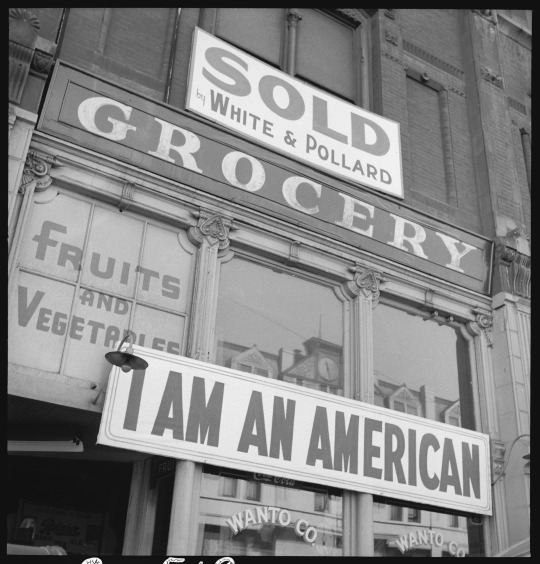
Image Caption: Oakland, California. Following evacuation orders, this store, at 13th and Franklin Streets, was closed. The owner, a University of California graduate of Japanese descent, placed the "I AM AN AMERICAN" sign on the store front on Dec. 8, the day after Pearl Harbor.
The deadline for grant applications is April 14, 2023. To learn more, and to submit an application, please visit the Civil Liberties Program page at https://www.library.ca.gov/grants/civil-liberties/.

Image Caption: Document from “Evacuee Property Department” with handwritten numbers showing the number of evacuees, vehicles, and property under Civilian Exclusion Order Number 23 (Vacaville).

Image Caption: Page one of the Official Exclusion Order (sometimes also called Evacuation Order) for Multnomah County, Oregon. “Instructions to all persons of Japanese ancestry” is written in large letters across the top.
#internment#japanese americans#california history#1940s#ww2#word war 2#world war ii#wwii#history#human rights#civil rights
92 notes
·
View notes
Text
I guess, this traitor is working for both Russia, and China, now.
"Former Rep. Adam Kinzinger (R-Ill.) said Thursday his former colleague, Hawaii’s Tulsi Gabbard (D), is “crazy” over her comments on the Japanese on National Pearl Harbor Remembrance Day. “This lady is crazy. Wut,” he wrote on the social media platform X, responding to a post from Gabbard about Pearl Harbor on the 82nd anniversary of the World War II attack.
“As we remember Japan’s aggression in the Pacific, we need to ask ourselves this question: is the remilitarization of Japan, which is presently underway, truly a good idea? We need to be careful that shortsighted, self-serving leaders do not end up bringing us again face-to-face with a remilitarized Japan,” Gabbard wrote.
5 notes
·
View notes
Text
MENTIONED YESTERDAY ON FREE HAWAI`I TV - WHAT IF THE NAVY GAVE MUCH OF PEARL HARBOR BACK TO HAWAI`I?

Honolulu Civil Beat - December 6, 2023 - By Naka Nathaniel
On the eve of the most solemn day at Pearl Harbor, I’d like us to look ahead 18 years from now.
Last week, I closed my column with a call to change the trajectory of the Navy, and the military at large, in Hawaii after a few years of terrible headlines. Today, I offer not precise solutions but something that will motivate us to act: A deadline.
We need to make Dec. 7, 2041, the most significant date in Hawaii in the 21st century.
Why?
The past few years have not been good for the Navy’s reputation in Hawaii. It’s remarkable to see how the botched handling of the Red Hill catastrophe unified so many varied groups in Hawaii against the Navy.
Those on Oahu who aren’t upset with the Navy yet will be when they see the rate increases in their water bills.
In conversation after conversation I’ve had about the military’s future in Hawaii, the end of the military’s multiple leases were repeatedly called “the elephant in the room.”
The elephant is also an opportunity that courageous leaders in Hawaii have to shape the future, instead of having it shaped for them.
For the first time in a long, long time, the people of Hawaii have the opportunity to have a say in what has traditionally been a one-way relationship.
In addition to being better partners and long-term guests and stewards, the military also has an opportunity to modernize its approach to national security here.
Gen. Mark Milley, the former head of the Joint Chiefs of Staff, warned in a report that the military’s current decision-makers are too connected to conventional tank and aircraft carrier warfare.
Hawaii’s strategic importance as the gas station of the Pacific has waned in the age of digital and drone warfare. It’s hard to conceive what warfare will look like in the age of hypersonic missiles and AI, but it’s possible that Hawaii’s geography can be used in more innovative and inspiring ways.
“The American homeland has almost always been a sanctuary during conflict, but this will not be the case in a future war,” Milley wrote.
Since the nature of national defense is changing, Hawaii needs to take advantage of this sea change.
Pearl Harbor served its purpose for the Navy and now it’s time for it to follow a proud tradition of hand off. Our memories don’t have to stretch too far back to think about the return of Hong Kong, the return of the Panama Canal, the Suez Canal, the bases in the Philippines and the dynamic change brought to many communities in the ‘90s when American military bases were reimagined in the wake of the Cold War.
We need to envision what a Pearl Harbor reintegrated into the fabric of Oahu would be like. For too long, Pearl Harbor has been off-limits for most Hawaiians.
What if the Navy returned significant parts of Pearl Harbor to Hawaii?
Would it make Hawaii more or less vulnerable? I would argue that it minimizes our exposure. We need to recalibrate what the Navy, and military presence at large, means here in the Pacific.
The people of Hawaii should be the beneficiaries of generously hosting the military for dozens of decades. Sites like Pearl Harbor have the infrastructure to solve myriad problems facing Hawaii.
It’s not too hard to see how a reimagined Ford Island could become the epitome of sensible 21st century living.
Or, with the threat of climate change being a menace at least as equal to security threats, some of Pearl Harbor could be converted into a hub for climate mitigation and resiliency efforts.
In 18 years, instead of only wreath-laying and somber remembrances, let’s envision a day that includes hope for the future.
Let’s envision a day, Dec. 7, 2041, when a partial handover occurs and a new dawn begins for a better Hawaii and a redeemed and reimagined military.
2 notes
·
View notes
Text
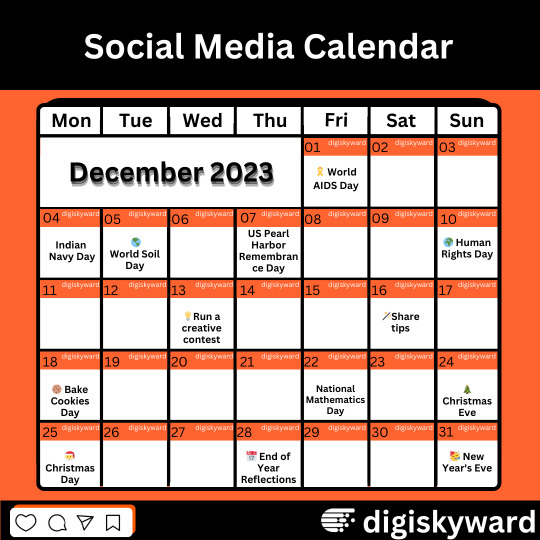
Unveiling December: Celebrations and Services with Digiskyward
December unfolds a tapestry of moments worth cherishing and commemorating worldwide. At Digiskyward, we're not just embracing these significant events but also offering our expertise in web development, SEO, and SMM to elevate your digital presence. Let's delve into the festivities and the ways our specialized services can amplify your online success.
1 Dec 2023 World AIDS Day
4 Dec 2023 Navy Day
5 Dec 2023 World Soil Day
7 Dec 2023 US Pearl Harbor Remembrance Day
10 Dec 2023 Human Rights Day
13 Dec 2023 Run a creative contest
16 Dec 2023 Share tips
18 Dec 2023 Bake Cookies Day
22 Dec 2023 National Mathematics Day
24 Dec 2023 Christmas Eve
25 Dec 2023 Christmas Day
28 Dec 2023 End of Year Reflections
3 notes
·
View notes
Text

The then newly-restored plaque in St. Mary’s Square honoring the “Americans of Chinese Ancestry” who gave their lives for America in its world wars, November 10, 2018. Photograph by Doug Chan.
The Last Full Measure: St. Mary’s Square Monument to the Fallen of Chinese America
In his book San Francisco Chinatown: A Guide to its History & Architecture, historian Philip P. Choy, shared his observations about the monuments in St. Mary’s Square as follows:
“Across from the statue of Dr. Sun Yat-sen is a less imposing but more significant monument, with 97 names of Chinese American soldiers of our community, who made the supreme sacrifice in World War I and II. Every year on Veterans Day, the Cathay Post No. 384 and the VFW Chinatown Post march to the square to honor those who died for us, that they never be forgotten. This commemorative plaque and day of remembrance are more symbolic of Chinese America than Sun Yat-sen’s statue and the “Ten Ten” celebration.”
During the Second World War, thousands of young men and women enlisted or were drafted from Chinatowns, Japantowns (and concentration camps), Manilatowns, and other small communities across the country.
According to the U.S. Department of Veteran Affairs and researchers at the Oakland Museum, 13,499 Chinese American men fought in the armed forces. (Community estimates range as high as 20,000.) Approximately 75 percent served in the US Army, with ground units such as the 3rd and 4th Infantry Divisions in Europe and the 6th, 32nd and 77th Infantry Divisions in the Pacific. A quarter of the total Chinese American personnel under arms served in the Navy. Still others served in specialized units, such as the all-Chinese American 1157th Signal Corps -- part of 14th Air Service Group that would join the fight against Imperial Japan in the China Burma India theatre of operations.
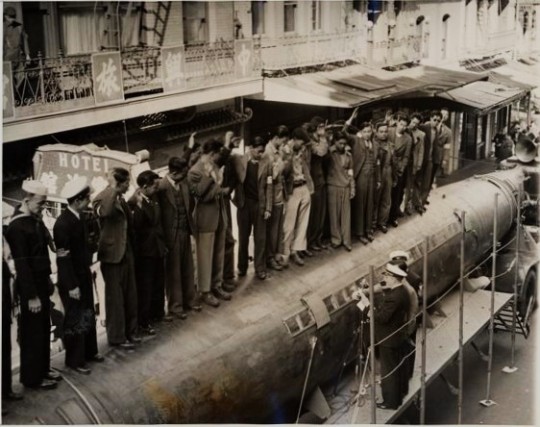
Group of Chinese recruits for the U. S. Navy taking their oath on top of a captured Japanese submarine, on Navy Day in San Francisco Chinatown, October 27, 1942. Associated Press photographer unknown (from the collection of the San Francisco Public Library). As written on the verso: ""A two-man Jap submarine, captured after the sneak attack on Pearl Harbor, T.H. [Territory of Hawaii], began its nation-wide tour in San Francisco Oct. 27. In Chinatown, Chinese recruits for the U.S. Navy lined up on the vessel and took their oath. It was part of Navy Day ceremonies."
The Chinese American men who served in the armed forces during WW II comprised 20 percent of all such men in the continental U.S. As historian Iris Chang would write decades later, “ethnic Chinese men gave their lives disproportionate to their presence in the country.”
As in many cities, the public spaces in San Francisco had included memorials to the fallen in America’s wars. On Memorial Day on May 30, 1919, city officials and thousands of spectators dedicated a 15-acre plot as the “Grove of Heroes,” in remembrance of the US dead and wounded in the First World War. In 1930, a sculpture originally created by M. Earl Cummings for the Pan Pacific International Exposition was acquired and installed in the meadow adjacent to the grove. The bronze figure holding a laurel wreath became known as the “Doughboy Statue,” and it is readily noticeable from the park’s John F. Kennedy drive and promenade. On Armistice Day (now known as Veterans Day), November 13, 1932, public officials assembled again to dedicate an 18-ton granite boulder (reportedly quarried from Twin Peaks) to commemorate US war dead. The monument, which was sponsored by the Native Sons of the Golden West, was inscribed with the names of 748 men and 13 women, all local soldiers and volunteers who died during the Great War.
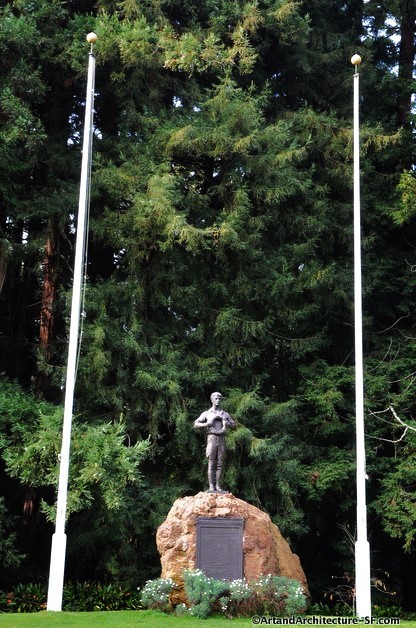
The Doughboy Statue in the “Grove of Heroes” in San Francisco's Golden Gate Park. The plaque, sponsored by the Native Sons of the Golden West and inscribed with the names of US dead in two world wars, omits the names of non-white military personnel killed in the line of duty.
Although Chinese Americans had served and died in WW I, no Chinese names had ever been inscribed in any of San Francisco’s war memorial monuments from that era. Their omission was hardly surprising. The Native Sons of the Golden West had been founded in July 1875 as a fraternal organization "embracing only the sons of those sturdy pioneers who arrived on this coast prior to the admission of California as a state." In the 1920s, the Native Sons adopted a white nativist stance on public policy issues. President William P. Canbu of the Native Sons wrote that “California was given by God to a white people, and with God’s strength we want to keep it as He gave it to us.” The Native Sons openly opposed Chinese, Mexican, and Japanese immigration. At the outset of the Second World War, the organization waged an unsuccessful legal battle for Japanese Americans to be disenfranchised.
The size of the returning cohort of Chinese American men (and the few women) from the Second World War had been unprecedented, and they produced a transformative generation of determined civic activists in the postwar era. As was the case with many other communities of color in the country, Chinese Americans had to struggle for acceptance and civil rights. Community activists such as John C. Young, a retired colonel from the United States Army and World War II veteran, made it their mission to join the struggle for Chinese Americans’ civil rights and participation in mainstream society. Young’s family led that effort by example as one of the first Chinese families to buy a home in defiance of racially-restrictive covenants against homeownership in San Francisco’s Richmond District (See the story here: https://www.outsidelands.org/chinese-in-the-richmond-alfred-john-young-and-connie-young-yu.php)
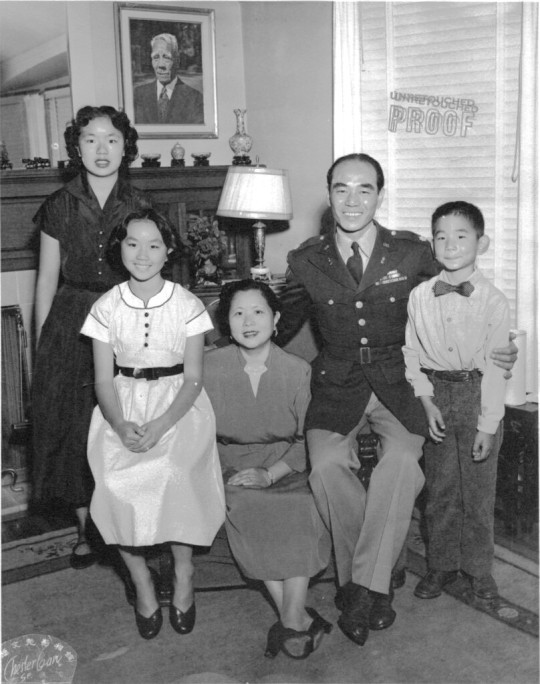
Left to right: Janey Young Cheu, Connie Young Yu, Mary Lee Young, Lt. Col. John C. Young, and Alfred John Young in the Young family house at 674 37th Avenue, circa 1952. (Courtesy of Al Young)
With the onset of the Cold War and actual armed conflict on the Korean peninsula, Chinese American leaders sensed that the path toward progress and acceptance of Chinese Americans had been jeopardized by the People’s Republic of China’s deploying troops to support North Korea’s military against UN forces.
As a commander of the American Legion Post #384 (Cathay Post), John Young and his fellow veterans spearheaded a proposal to erect a war memorial to the fallen Chinese American Veterans of World War I and World War II.
In 1951, the same year in which the Native Sons added the names of 16 white members who had died in World War II to the plaque on the rock pedestal of the Doughboy Statue, Chinese American veterans’ proposal to honor their fallen comrades in Chinatown gained acceptance.
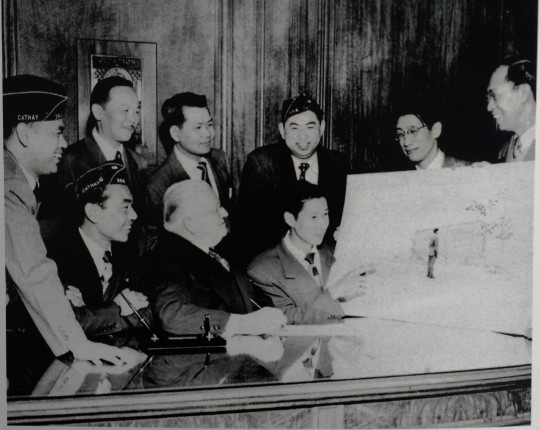
Members of the VFW Chinatown post and Cathay Post no. 384 of the American Legion huddle and review conceptual drawings for a St. Mary’s Square monument with San Francisco Mayor Elmer Robinson in the Mayor’s office in City Hall, c. 1951. Standing (left to right): Lim P. Lee, Peter H. Wong (unidentified veteran), Shaw Pange, Charles Leong, and Joseph Quan. Sitting: John C. Young, Mayor Elmer Robinson, and James Hall. Photographer unknown (from the collection of the late Col. John C. Young and his daughter Connie Young Yu).
Before 1951, a large and dramatic stainless steel statue of Dr. Sun Yat-sen, designed local sculptor Benny Bufano, represented the principal statuary in St. Mary's Square.
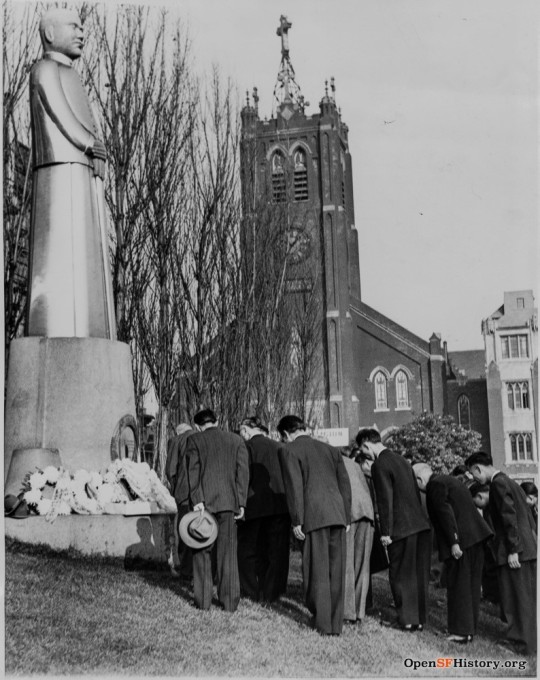
St. Mary's Square Nov 12, 1943. In this view of St. Mary's Square, looking north toward Old St. Mary's Church, members of San Francisco’s Chinese community bow before the statue of Sun Yat Sen on the occasion of Dr. Sun’s birthday. Among those attending the ceremony was Tse Kiong Sun, grandson of Sun Yat Sen. Photographer unknown (Courtesy of a private collector).
According to historian Phil Choy, the statue had been commissioned by the Chinese Six Companies to commemorate October 10, 1911, the day Dr. Sun's revolutionary party overthrew the Manchu government and established the Republic of China. As Choy wrote in 2012:
“For almost a century, October 10th, known by the Chinese as “Ten Ten,” was a major day of celebration in the community. Banners stretched across Grant Avenue. Organized by the Chinese Six Companies, drum & bugle corps and pupils from every Chinese language school dutifully paraded through the streets. Today the celebration no longer has 100% community support. Members of the Chinese Six Companies are divided; some still embrace the Kuomintang (KMT) Party of the former Republic of China (now the Taiwanese Government), while others support the People’s Republic of China.”
The efforts by the Chinese community’s veterans and supporters to honor the fallen of two world wars culminated in 1951 with the installation and dedication of the memorial plaque still seen today in St. Mary's Square.
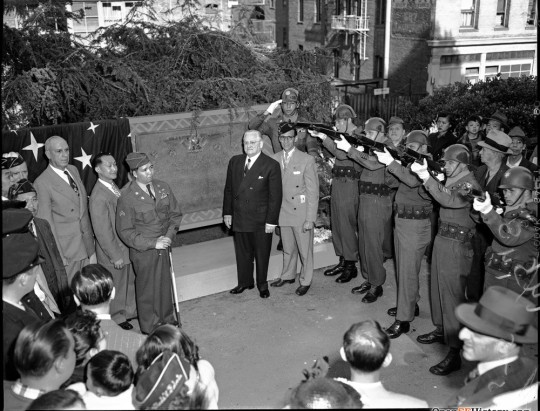
“Soldiers firing salute at dedication of memorial to deceased Chinese-American veterans at St. Mary's Square,” May 28, 1951. Mayor Elmer Robinson stands at center in dark suit. Photographer Unknown (Examiner Negative Collection / courtesy of a private collector)
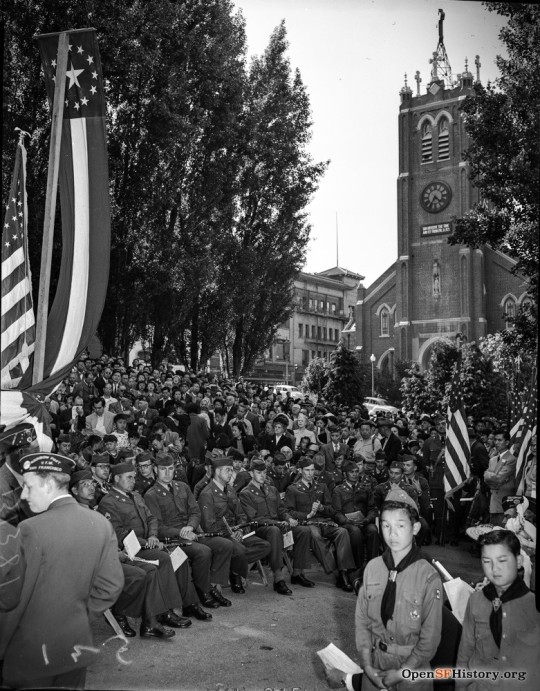
A large crowd attended the dedication ceremonies for the Chinese veterans memorial at St Mary’s Square on May 28, 1951. An Army band is seated with musical instruments, and members of the Chinatown Boy Scouts troop appear in the right foreground. Photographer unknown (form a private collection).
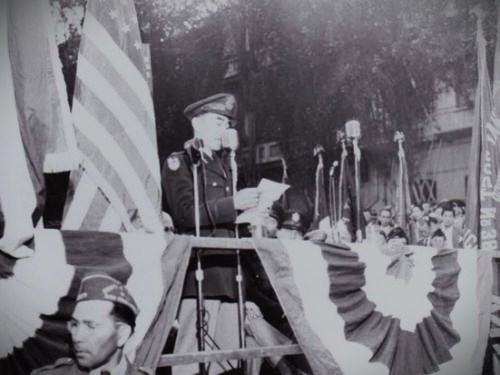
Civic leader and president of the Wing Nien Soy Sauce Co. Col. John C. Young (ret.) speaks to the crowd assembled on May 28, 1951, for the dedication of the memorial to Chinese American service personnel killed during the First and Second World Wars. His speech to the crowd occurred in the presence of his former commanding officer, General Albert Wedemeyer, under whom Young served as a heavy weapons officer in the China-Burma-India theater of operations.
If the irony of Chinese Americans' entering the US armed forces during wartime was apparent, it was never expressed publicly by those who had served honorably. Native-born, as well immigrants ineligible to naturalize as citizens by punitive immigration laws, had answered the call to service for an America that had, for most of the previous century, robbed, murdered, burned, lynched, taxed, and excluded the pioneer generations, while building much of the political economy of the American West on the strength of Asian labor.
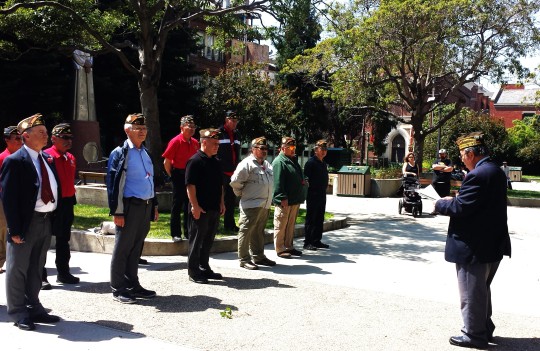

Veterans from Chinatown's American Legion Cathay Post 384 and VFW Chinatown Post 4618 assembled on Memorial Day 2016 in front of the WW I and II memorial plaque in St. Mary’s Square to commemorate the Chinese American fallen in all the nation’s conflicts and wars. Photograph by Doug Chan.
The numbers of Chinese Americans KIA and MIA from the world wars remain imprecise. The honored dead, including Medal of Honor recipient Capt. Francis B. Wai are, and will be, remembered in perpetuity for their extraordinary heroism and devotion to duty. For others, such as Lt. Kenneth Kai-Kee, the memories, grief and loss of those he left behind have already faded with the passing of family, friends, and loved ones.
The passage of time confers on community historians the duty to impart to each new generation the mission to remember the wartime sacrifices of Chinese America's sons and daughters. The debt to those who gave the last full measure of devotion must be honored in perpetuity.

Photograph by Doug Chan.
#St. Mary's Square#Cathay Post veterans#Col. John C. Young#Francis B. Wai#Kenneth Kai-Kee#Lim P. Lee#Peter H. Wong#Shaw Pang#Charles Leong#Joseph Quan#Chinese American veterans memorial
1 note
·
View note
Link
A Proclamation on National Pearl Harbor Remembrance Day, 2023 - https://www.timesofupdate.com/a-proclamation-on-national-pearl-harbor-remembrance-day-2023/
0 notes
Text
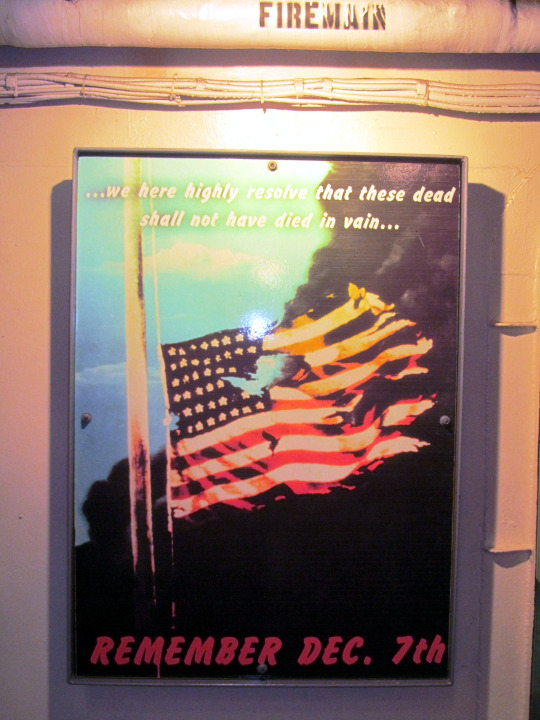
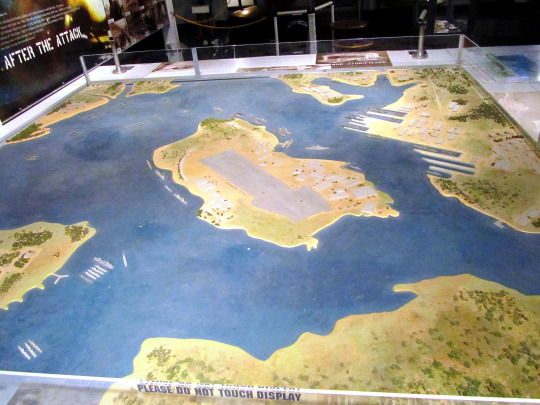



National Pearl Harbor Remembrance Day
On the morning of December 7, 1941, Japan launched a surprise attack on Naval Station Pearl Harbor, located in Honolulu, Hawaii, on the island of Oahu. National Pearl Harbor Remembrance Day remembers and honors the 2,403 citizens of the United States who lost their lives there that day. Veterans and citizens have commemorated the anniversary of the attack on Pearl Harbor since it took place, but the day became an official observance when Congress designated the day with a joint resolution on October 3, 1984. The resolution authorized and requested the President to issue a proclamation calling upon the people of the United States "to observe this solemn occasion with appropriate ceremonies and activities" and "to pledge eternal vigilance and strong resolve to defend this Nation and its allies from all future aggression." Accordingly, President Ronald Reagan issued Proclamation 5286 on December 4, 1984. Subsequent Congresses and presidents have passed resolutions and issued proclamations for the day. On the day, flags are flown at half-staff until sunset to honor those who died from the attacks. Events, including a commemoration ceremony, are held at the Pearl Harbor National Memorial.
Although the attack on Pearl Harbor was a surprise, tensions had been building between the United States and Japan for years. In the 1930s, Japan expanded into China, taking over its import market, agitating the United States. Japan invaded China in 1937 and subsequently participated in the Nanjing Massacre. During the following year, the United States gave its first loan to China. The United States instituted economic sanctions and trade embargoes with hopes they would keep Japan from expanding. In July 1939, the United States terminated the Treaty of Commerce and Navigation, which had stood with Japan since 1911. In the summer of 1940, the United States began restricting the export of some materials to Japan that would be useful to them in war. In July 1941, all commercial and financial connections with Japan were cut off, Japan's assets were frozen, and an embargo was placed on petroleum and other war materials. Concurrently, the United States stepped up aid to China, which did not please Japan's militarists. Japan did not shift course and tensions continued to rise.
Japan ordered the attack on November 5, but negotiations took place between Japan and the United States right up until the day of the attack, and Japan's commanders were told that they may be recalled if negotiations produced a favorable outcome. On November 26, the Japanese fleet stationed itself about 275 miles north of Hawaii. It was from this location that around 360 planes eventually launched to Pearl Harbor.
On more than one occasion, most notably on November 27, U.S. Army and Navy commanders at Pearl Harbor were warned that an attack was possible. They took some steps, but as they did not think that an attack would happen, their preparations were far from adequate. Washington didn't take the steps that were needed to be prepared either—they didn't expect Japan to attack Hawaii as Japan was about 4,000 miles from the island and Hawaii was about 2,000 miles from mainland United States. There were also some indications right before the attack that should have raised red flags that one was imminent. Early on the morning of the attack, it was learned in Washington that the Japanese ambassadors wanted an interview with the secretary of state at 1:00 p.m. (7:30 a.m. Hawaii time), which signaled war. Meanwhile, in Pearl Harbor, a Japanese submarine was spotted by a minesweeper four hours before the attack. Then, an hour and a half before the attack, the USS Ward, a destroyer, transmitted a message saying that it had engaged the submarine. Additionally, U.S. Army Pvt. George Elliott detected incoming planes on a radar screen, but he was told by his lieutenant that B-17 bombers from the United States were soon to arrive, so he should disregard what he saw.
On the morning of Sunday, December 7, 1941, at 7:55 a.m. Hawaii time, the first of hundreds of fighter planes, bombers, and torpedo planes of the Imperial Japanese Navy Air Service attacked Naval Station Pearl Harbor. After much success, Japan launched a second wave of attack at 8:50 a.m., which lasted until shortly after 9 a.m. Most of the United States Pacific Fleet was moored around Ford Island in the center of the harbor at the time, and many airplanes were parked at nearby airfields. Japan's goal was to take out the fleet, and then to go on to other parts of the South Pacific, which the United States would then be unable to defend.
The attack on Pearl Harbor left 2,403 United States citizens dead, including 2,335 service members and 68 civilians. Additionally, 1,178 Americans were injured. Most of the damage was done in the first 30 minutes of the attack. Around 8:10 a.m., a 1,800-pound bomb was dropped on the USS Arizona, which went through the deck and into the forward ammunition magazine, causing the ship to explode and 1,177 of its crew members to perish. Following the destruction of the USS Arizona, torpedoes hit the USS Oklahoma, which sank, causing the loss of life of 400 sailors. The USS Utah—a battleship that was converted to a target ship in 1931—was sunk and 58 lost their lives. The rest of the battleships at the harbor were either sunk or damaged, and there were casualties on each vessel, including the USS California, USS West Virginia, USS Maryland, USS Pennsylvania, USS Tennessee, and USS Nevada. Each of these six battleships would eventually be returned to service. Three destroyers, three cruisers, and one minelayer were damaged. Aircraft were also targeted, with 159 being damaged and 188 being destroyed, most while parked at Naval Air Station on Ford Island and at nearby Wheeler and Hickam fields.
Although these losses and damages were disastrous for the United States, the Pacific Fleet's three aircraft carriers were away from the base at the time, remaining unscathed, which was of immense importance. Some cruisers and destroyers were also near the aircraft carriers, out of harm's way. Of additional importance, parts of Pearl Harbor—submarine docks, shipyards, repair shops, and oil storage depots—were not harmed. As for the Japanese, they lost fewer than 100 men, 60 or fewer planes, five midget submarines, and perhaps one or two fleet submarines in the attack.
The events of Pearl Harbor unified the American public and precipitated the almost immediate entry of the country into World War II. The day after the attack, President Franklin Delano Roosevelt made a speech to Congress in which he said December 7, 1941, was "a date which will live in infamy." He went on to say, "No matter how long it may take us to overcome this premeditated invasion, the American people in their righteous might will win through to absolute victory. I believe I interpret the will of the Congress and of the people when I assert that we will not only defend ourselves to the uttermost, but will make very certain that this form of treachery shall never endanger us again." He closed out his speech by asking Congress to declare war on Japan. Congress declared war the same day and the United States entered World War II on the side of the Allies. When Germany and Italy declared war on the United States three days later, the US declared war on them as well.
On National Pearl Harbor Remembrance Day, we remember and honor those who lost their lives on today's date in 1941 at Pearl Harbor. We fly the flag at half-staff and attend events in their honor. We remember the great significance of the day and how it brought the United States into World War II, forever changing the nation.
How to Observe National Pearl Harbor Remembrance Day
The day should be spent remembering and showing honor for those who lost their lives at Pearl Harbor. The following are some ideas on how to observe the day:
Attend the National Pearl Harbor Remembrance Day Commemoration Ceremony, which takes place outside of the Pearl Harbor Visitor Center at the Pearl Harbor National Memorial. If you are unable to attend, you can view its live broadcast online. Other events are also held at Pearl Harbor on today's anniversary.
Visit the Pearl Harbor National Memorial. This site is home to the USS Arizona Memorial. Dedicated on Memorial Day in 1962, the ship's memorial is located over the sunken battleship. It is open to the public and can be reached by taking a free boat tour from the Pearl Harbor Visitor Center. The USS Oklahoma Memorial and the USS Utah Memorial are also part of the Pearl Harbor National Memorial. (Note: the USS Utah Memorial, located on the west side of Ford Island, may only be visited by those with military IDs who drive themselves to it.)
Watch videos from the Pearl Harbor National Memorial and view photos from National Pearl Harbor Remembrance Day commemoration events.
Visit the Pearl Harbor Aviation Museum.
Watch President Franklin Roosevelt's December 8, 1941, address to Congress.
Visit the USS Bowfin Submarine Museum and Park. Located at Pearl Harbor, it is dedicated to a ship that sank 44 ships during World War II.
Visit the USS Missouri Memorial. World War II ended with Japan's surrender on board the USS Missouri. The ship is now located at Pearl Harbor and is a memorial.
Fly a flag at half-staff.
Visit The National World War II Museum in New Orleans.
Watch a documentary about Pearl Harbor.
Watch a film about Pearl Harbor.
Read a book about Pearl Harbor.
Source
#National Pearl Harbor Remembrance Day#7 December 1941#anniversary#US history#WWII#World War Two#World War II#interior#model#USA#USS Lexington Museum - National Historic Landmark#USS Lexington (CV-16)#USS Lexington Museum On The Bay#Corpus Christi#Texas#summer 2011#original photography#technology#engineering#vacation#travel#ship#tourist attraction#landmark#NationalPearlHarborRemembranceDay
0 notes
Text
USS Utah Ceremony.
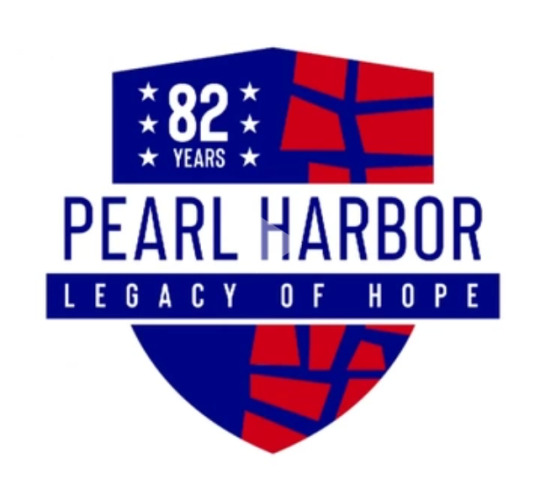
82nd Commemoration of the National Pearl Harbor Remembrance Day.
USS Utah Ceremony.
December 6th, at 5:00 pm HST (10:00 pm EST)
0 notes
Text
Holidays 12.7
Holidays
Armed Forces Flag Day (India)
Blue Marble Day
Christmas Jumper Day (UK)
Cypress Tree Day (French Republic)
Dia de las Velitas (Day of the Little Candles; Colombia)
Enlightenment Day
Ferry Floss Day (UK)
Fetes de l’Escalade (Scaling or Climbing Day; Switzerland)
Hang a Wreath Day
Heavy Snow Day (Chinese Farmer’s Calendar)
Human Rights Day (Kiribati)
International Civil Aviation Day (UN)
Letter Writing Day
Memorial Day (East Timor)
National Day (Myanmar)
National FAFO Day
National Fire Safety Day
National Heroes’ Day (East Timor)
National Illinois Day
National Joy Day
National Judith Day
National Letter Writing Day
National Rina Day
National Slime Day
Pearl Harbor Remembrance Day
Spider-Woman Day
Spitak Remembrance Day (Armenia)
Students’ Day (Iran)
World Kamishibai Day
World TTTS Awareness Day
Food & Drink Celebrations
Marshmallow Peeps Day
National Cotton Candy Day [original date, moved to 6.11; also 7.31]
National Prosciutto Day
1st Thursday in December
Kid Lit Art Postcard Day [1st Thursday]
Lover's Fair (Arlon, Belgium) [1st Thursday]
Independence Days
Delaware Statehood Day (#1; 1787)
Farrar Republic (Declared; 2016) [unrecognized]
Fraughtia (Declared; 2012) [unrecognized]
Feast Days
Aemilianus (Greek Church)
Ambrose of Milan (Christian; Saint) [Italy]
Bhairava Ashtami (Indian Goddess of Soma) [8th Lunar Day of Kartik]
Bradley (Positivist; Saint)
Bruma II (Pagan)
Eve of the Immaculate Conception
Fara (Christian; Saint)
Feast of All Monsters (Church of the SubGenius)
Festival of Primordial Beings
Flag Day (India)
Flag Land Base Day (Scientology)
Gian Lorenzo Bernini (Artology)
Haloia of Demeter (Pagan)
Hanukkah (Judaism) [begins at sundown]
Holiday from Death Day (Pastafarian)
Maria Giuseppa Rossello (Christian; Saint)
Quema del Diablo (Burning of the Devil; Guatemala)
Rosita (Muppetism)
Sabinus of Spoleto (Christian; Saint)
Still Not Dead Day (Pastafarian)
Stuart Davis (Artology)
Lucky & Unlucky Days
Butsumetsu (仏滅 Japan) [Unlucky all day.]
Dismal Day (Unlucky or Evil Day; Medieval Europe; 23 of 24)
Egyptian Day (Unlucky Day; Middle Ages Europe) [23 of 24]
Fatal Day (Pagan) [23 of 24]
Historically Unlucky Day [11 of 11]
Historically Bad Day (Cicero assassinated, Pearl Harbor attack & 4 other tragedies) [11 of 11]
Umu Limnu (Evil Day; Babylonian Calendar; 56 of 60)
Very Unlucky Day (Grafton’s Manual of 1565) [56 of 60]
Premieres
Abbott Elementary (TV Series; 2012)
Anastasia: The Mystery of Anna (TV Mini-Series; 1986)
Bad Day at Flat Rocky or A Record in Bullwinkle’s Blot (Rocky & Bullwinkle Cartoon, S6, Ep. 326; 1964)
The Bells of St. Mary’s (Film; 1945)
Brokeback Mountain (Film; 2005)
Canine Patrol (Disney Cartoon; 1945)
Dominique, by The Singing Nun (Song; 1963)
Edward Scissorhands (Film; 1990)
Frosty the Snowman (Animated TV Special; 1969)
The Golden Compass (Film; 2007)
The Gondoliers, by Gilbert & Sullivan (Comic Opera; 1889)
The Grifters (Film; 1990)
Hallelujah, by Leonard Cohen (Song; 1984)
Homo Ludens: A Study of the Play Element in Culture, by Johan Huizinga (Science Book; 1938)
I’m Not There (Film; 2007)
Jamboree (Rock & Roll Film; 1957)
Kung Fu Fighting, by Carl Douglas (Song; 1974)
The Librarians (TV Series; 2014)
The Long Tomorrow, by Leigh Brackett (Novel; 1955)
Mary Queen of Scots (Film; 2018)
New Kin in Town, by The Eagles (Song; 1976)
Ocean’s Eleven (Film; 2001)
Resign Your Fate to a 52nd State or Moosylvania (Rocky & Bullwinkle Cartoon, S6, Ep. 325; 1964)
Rock! Rock! Rock! (Rock & Roll Film; 1956)
Rosemary, played live by the Gratefull Dead (Song; 1968) [Only Time It’s Played Live]
(Sittin’ On) The Dock of the Bay, recorded by Otis Redding (Song; 1967)
Star Trek: The Motion Picture (Film; 1979)
2010: The Year We Make Contact (Film; 1984)
Wild Life, by Paul McCartney & Wings (Album; 1971)
The World’s Fastest Indian (Film; 2005)
Today’s Name Days
Ambrosius, Benedikte (Austria)
Ambrozije, Sabina, Urban (Croatia)
Ambrož (Czech Republic)
Agathon (Denmark)
Piine, Sabiine (Estonia)
Sampsa (Finland)
Ambroise (France)
Ambros, Benedikte, Farah (Germany)
Amvrosios (Greece)
Ambrus (Hungary)
Ambrogio (Italy)
Anta, Antonija, Dzirkstīte, Tonija (Latvia)
Ambraziejus, Daugardas, Tautė (Lithuania)
Hallfrid, Hallstein (Norway)
Agaton, Ambroży, Marcin, Ninomysł (Poland)
Filofteia (Romania)
Ekaterina (Russia)
Ambróz (Slovakia)
Ambrosio (Spain)
Angela, Angelika (Sweden)
Ambrose (Ukraine)
Ambrose, Ambrosine, Jasmin, Jasmine, Jazlyn, Jazmin, Jazmine, Yasmeen, Yasmin, Yasmine, Yazmin (USA)
Today is Also…
Day of Year: Day 341 of 2024; 24 days remaining in the year
ISO: Day 4 of week 49 of 2023
Celtic Tree Calendar: Ruis (Elder) [Day 10 of 28]
Chinese: Month 10 (Gui-Hai), Day 25 (Ji-Hai)
Chinese Year of the: Rabbit 4721 (until February 10, 2024)
Hebrew: 24 Kislev 5784
Islamic: 24 Jumada I 1445
J Cal: 11 Zima; Foursday [11 of 30]
Julian: 24 November 2023
Moon: 27%: Waning Crescent
Positivist: 5 Bichat (12th Month) [Bradley]
Runic Half Month: Is (Stasis) [Day 12 of 15]
Season: Autumn (Day 75 of 89)
Zodiac: Sagittarius (Day 16 of 30)
1 note
·
View note